Pakistan Conflict Tracker Monthly Report (June 2013). By Mohammad Nafees
The month of June dawned with lots of hopes and expectations for the people of Pakistan as the new government was to take oath during this month and to offer peace, good governance, and rule of law in the country. The hope of peace got shattered when a drone attack – 11th in 2013 thus far – killed second-in-command Taliban leader, Wali-ur-Rehman Mehsud on 8 June. This prompted the Taliban to revoke their earlier offer for peace talks, and instead avowed avenge for Mehsud’s death. Soon thereafter, the Pakistan Tehreek-i-Insaaf (PTI) whose chairman Imran Khan had been supporting the idea of negotiation with the Taliban, tabled a bill in the parliament, asking the US to stop the drone strikes. This resolution in the provincial parliament, however, could not prevent two PTI MPA from becoming victims of TTP attacks.
Target killings and acts of terrorism remained the most recurring causes of casualties in the country during June, totaling about 616 deaths and 535 wounded, a figure close to what it was during the last month. Among the victims were 33 women and 6 children as well. This is the highest number for female and children that fell victim to indiscriminate terrorism in one month.
Terrorism in Balochistan took another sinister turn when alleged Baloch nationalist militants attacked the residency of the country’s founder Mohammad Ali Jinnah, followed by a suicide attack on a bus carrying students of the solo women university in Baluchistan. Soon thereafter, on June 21st, terrorists executed at least eight foreign mountaineers at a height of 4,200 meters. They also beheaded one of the Jirga members who had gone for a meeting with militants on the request of Prime Minister Nawaz Sharif’s PML (N) party. Target killings of political leaders and activists continued during this month particularly in southern Sindh province.
All these events and other facts reported in the national newspapers are collected to make this report as informative and factual as possible. Errors and omissions, as always a possibility in all statistical works including this one, are expected. However, such mistakes do not grossly affect the basic objective of this report. This report mainly covers the following topics:
Target killings, Kidnapping for ransom and target killing, Terrorism and Security, operation, Sectarianism, Drone attacks
CRSS will appreciate receiving comments that the readers may have on this report.
Report prepared by: Mohammad Nafees, Senior Research Fellow, Center for Research and Security Studies. Data compilation by: Fariha Farry
NOTE: Readers can approach CRSS for source of any information included in the report. Please send your request to: [ mail@crss.pk and info@crss.pk ]
Deaths due to violence in the country during June 2013:
In June, the highest number of deaths was reported in Sindh province – all of them mainly in Karachi (See graph 1 & 2 below). Major causes of deaths in the country during the month of June can be distributed in four major categories; Target Killings, Terrorism, Security operation and Sectarianism. Among all categories, target killings appear to have had the highest victims while terrorism, security operation, and sectarianism were the next three major causes of death in the country (See graph 3). The victims of violence belonged to all segments of life, the highest among them were civilians followed by militants, security officials, and politicians (See graph 4).
Graph 1: Number of people killed in provinces due to violence: Graph 2: Number of persons killed in cities:
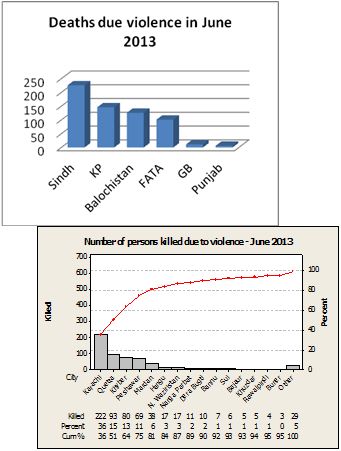
Graph 3: Nature of violence in Pakistan – June 2013
Graph 4: Victims of violence – June 2013
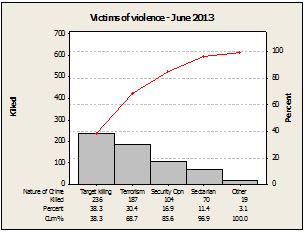
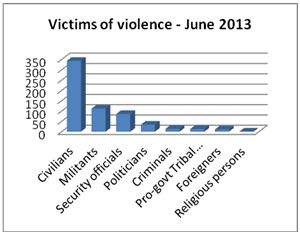
The interesting point to note is that different provinces suffered violence that was different in nature and intensity ; like Baluchistan (especially Quetta) was highly affected by anti-shia sectarianism while KPK and Sindh (especially Karachi) were affected by terrorism, security operations, and sectarianism. FATA had only Terrorism and Security Operations as the causes of death there.
Target killings:
As many as 236 people lost their lives in target killings, most of them were in Sindh (184) while 36 in Balochistan, 14 in KPK and only 2 in Punjab. As the nature of target killings varies from province to province, we will discuss each province separately. The perpetrators and the victims of target killings vary and thus a closer look at this aspect of the problem may help us have a better idea of the factors that motivate perpetrators to kill innocent people.
Target killings in Sindh:
Karachi, the largest commercial city of the country that inhabits people from all provinces, reflects a very scary scenario because of rampant crime of various nature. (See graph 6 below) that endanger human lives. Target killing is the most common form of violence in the city that caused the highest number of death each month. Karachi alone lost 180 persons due to target killings while Hyderabad lost 2 persons and Larkana 2. Most of the victims of target killings in Karachi were activists of political and religious groups though some Taliban militants were also reportedly got killed in such incidents. This way Karachi stands out as the worst-hit by target-killings but major cities in Balochistan and KPK, too, have suffered this form of violence against selected targets. (See graph 5 below). Punjab, Gilgit Baltistan (northern Pakistan), and FATA, however, remained almost unaffected during June.
Graph 5: Target killings in cities:
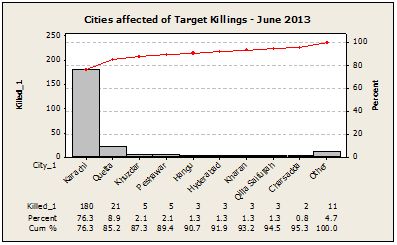
Taliban militants, whose activities had remained restricted mostly to northwestern Pakistan, have in recent years also become visible in Karachi, with the Muttahida Qaumi Movement (MQM) making noises about Taliban militant’s anti MQM campaign. The MQM has also been accusing Pashtun nationalists of using militants to make inroads in Karachi. In June, Taliban claimed responsibility for killing MQM Sindh assembly member Sajid Qureshi, his 25-year-old son, and his driver[1]. On June 22, 2013, two activists of Taliban were killed in Karachi, one of them identified as Tehreek-e-Taliban Pakistan (TTP) commander Bhalu Bhai, who was reportedly running a criminal network from Kati Pahari and Manghopir[2]. During security operations in the city three suspects, Ghaniur Rehman, Ghulam Ishaq and Nazrab Khan, were arrested from Manghopir and Mauripur areas and they were reported to be linked to the outlawed Tehrik-e-Taliban Pakistan[3], [4]. Another frequent cause of target killing during June was the rivalry of different gangs operating in Lyari and its adjacent areas. PPP and MQM quite often accuse each other of supporting criminal gangs linked with larger , syndicates being patronized and protected by political interests.
Graph 6: Nature of violence in Sindh:
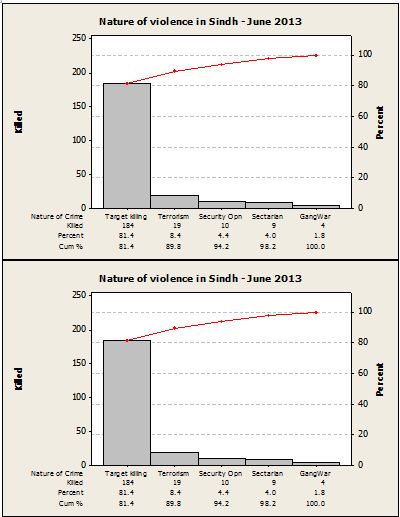
Sectarianism exacerbated by the political rivalries also instigates perpetrators for targeting their rivals in the city. After the MQM, the next highest victims of target killings in Sindh are from religious outfits such as Ahl-e-Sunnat wal Jamat (ASWJ). ASWJ (ex Sipah-e-Sahaba – banned Sunni Muslim extremist group) is supposed to have links with militant outfits including TTP and Lashkar-e-Jhangvi (LeJ). In Karachi, it seems MQM is now facing two militant rivals — Taliban and LeJ. This rivalry heightens the target killings incidents in the city.
Target killings in Balochistan:
As many as 21 out of 36 victims of target killings in Balochistan were in Quetta, the majority of the victims being civilians. The other affected areas in Balochistan were Dera Bugti, Kharan, Khuzdar, and Qilla Saifullah. Three policemen and one para-military official were killed in Qillah Saifullah and Khuzdar. In another incident, unknown armed men opened indiscriminate firing on a bus and killed three passengers on the spot. In Dera Bugti, two persons from Tribal Peace Lashkars were killed in an indiscriminate firing by some unidentified armed men. The target killings in Balochistan appear to have their links with nationalist movement, sectarianism, and terrorism.
Target killings in KPK:
In KPK, target killings caused seven civilian and six security personnel deaths. Among the civilians were one PTI worker, two health workers, one driver of Dr Shakir Hussain of Lady Reading Hospital, and bullet riddled bodies of two persons who were missing for some time. In a target attack, DSP Traffic Amanullah and his gunman was killed in Saeedabad, Peshawar. Two days later, the incharge of Hyatabad Police Station was shot dead at Peshawar’s Karkhano market when he was escorting a convoy of trucks carrying supplies for NATO troops in Afghanistan. A PTI worker, Altaf Hussain, was killed by gunmen in an attck on his house in Nowshera. In a seprate attack, Hussain’s colleague remained unhurt. The target killings in KPK seem to stem from certain outlawed militant organizations’s opposition to polio vaccination drive as well as rejection of the democratic system in the country.
Target killings in Pujab:
The phenomenon of target killings is almost non-existant in the most populous Punjab province. Only two incidents were reported in June. The first incident was reportedly related to a land dispute in which the General-Secretary of Jamiat Ulema-e-Pakistan, Attock, Daud Mustafai, was shot dead whereas in the other incident, a newly elected chairman of the Wapda Employees Union Javed Ashraf was killed in Faisalabad. Both of these incidents are very different in nature and motivation for target killing that are observed in Karachi, Quetta, and Peshawar.
Target killings of political activists and parliamentarians:
During June, nearly 34 political activists and parliamentarians belonging to different political parties were the victims of target killings and bomb attacks.
PTI MPA Farid Khan from Hangu (southern KP)
PTI MPA Imran Khan Mohmand, an independent legislator, K-P Assembly from PK-27.
MQM MPA from PS103, Sajid Qureshi, in his early 50s, and his 25-year-old son
Graph 7: Parliamentarians and political activists died in June:
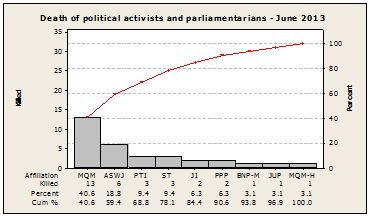
Kidnappings for ransom and target killings:
An incident of target killing in Peshawar brought to light another aspect of this crime that can be associated with kidnappings for ransom crime. On 12 June 2013, an attempt to kidnap a Shia orthopedic surgeon Dr Shakir Hussain resulted in the death of his guard and one of the two criminals.These criminals were wearing police uniform and the police later claimed they were both from a Central Asian country. Police also arrested a tailor from Lal Kurti Bazar on charges that he was involved in making police uniforms for the accomplices[5]. Kidnapping for ransom and extortion are two crimes that sometime end up in killing of the people they target for abduction. In the month of June, following prominent people were kidnapped in the country:
01 June: Four persons, including a government contractor, were kidnapped in Chinarak area in central Kurram Agency[6]
02 June: Police freed a kidnapped doctor (Dr Salim Khokhar) in a raid in Gulshan-e-Maymar[7]
02 June: A doctor was shot dead in Bajaur[8]
03 June: Lashkar-e-Islami (li) kidnapped 60 members of tribal jirga that was sent to them by Suhail Afridi, a PMLN candidate for NA-46. Later, one of the kidnapped persons was beheaded by LI and his dead body was dumped on roadside in Droadda area of Bara tehsil on 7 June 2013[9].
06 June: Two magistrates were kidnapped in the limits of Sultan Kot Police Station of Shikarpur[10]
07 June: Sukkur Police in southern Pakistan got freed three kidnapped shopkeepers. They were kidnapped by a gang of dacoits for ransom three days earlier from village Faras.[11]
07 June: A doctor named Saifur Rehman was kidnapped from Khyber tribal region’s Bara area[12] near Peshawar.
12 June: Kalimullah was kidnapped from Chamkani Square, Peshawar. The family later received a call to arrange Rs50 million as ransom. The cops raided the house of Salim in Kakshal locality and recovered the kidnapped man[13].
12 June: Dr Ashraf Bukhari who was kidnapped from Gulberg, Peshawar over a month ago returned home safe and sound. His family had also received calls for ransom[14].
12 June: Shia Dr Shakir Hussain was injured in a kidnapping attempt in Peshawar[15].
14 June: Dr Muhammad Anwar, Dr Ayaz, Dr Nasrullah, their clerk Muhammad Farooq and driver Muhammad Anwar went missing from Loralai[16].
17 June: Mehrullah Magsi and his driver were kidnapped from Mastung[17].
20 June: Dr. Javed Iqbal was kidnapped from Sadiqabad[18].
20 June: Dr Mubashir Hassan, a civil surgeon at the District Headquarters Hospital in Chaman was freed. He was kidnapped on 27 April [19].
On 29 June 2013, three members of Teheeik-e-Taliban Pakistan (TTP) were arrested from Islamabad on charges of extortion from from industrialists, business tycoons and lawyers of the twin-cities of Rawalpindi-Islamabad and Khyber-Pakhtunkhwa[20]. The report also said, “a former federal minister and now adviser to the prime minister, a former provincial minister of KP, top politicians, members of Parliament, businessmen, owners of tobacco factories and lawyers were among the people who received threatening letters followed by telephone calls from North Waziristan and Afghanistan.”
According to the report, a famous lawyer received a letter and telephone call from TTP people. The letter asked the lawyer to foot a two-day bill for “Mujahideen-e-Islam” or be ready to face the consequences. An industrialist, owner of a vegetable oil mill in Islamabad, was kidnapped from Islamabad and the captors demanded over 500 million rupees as ransom but settled for 70 million rupees but he hasn’t yet been freed. The group had threatened various factory owners in KPK, hotel owners in the mountainous summer resort Murree near Islamabad, and planned to extort money from the business community of Rawalpindi and Islamabad.
All these incidents of kidnappings and these warning letters and phone calls from TTP show that militants are using abductions for ransom as a major means of funding. This also underscores the nexus between criminal syndicates and religious militants.
Terrorism and security operations:
Terrorism inflicted deaths in all provinces of the country with the exception of Punjab and the highest affected of it was KPK followed by FATA, Balochistan, Sindh, and Gilgit (See graph below). The majority among the victims of terrorism and security operations were militants (106), followed by civilians (102), security officials (50), Foreigners (11) and members of tribal militia (11).
The month of June had begun with an army operation against militants in the Kurrum Agency border region that resulted in death of 23 militants and two soldiers on 2 June. On 6 June, FC carried out a search operation in Kharotabad, Quetta that ended in death of five suspects including two women and a child. On 10 June, the security forces claimed to have gained full control of the heights on the central Derastani ridge that overlooks the entire Maidan and Kukikhel valley in the Khyber Agency’s Tirah Valley and Kurram Agency. The operation left 35 militants dead and nearly 15 wounded. On the same day, coincidently or as a retaliation of these security operations, a roadside bomb blast struck a military convoy, killing six soldiers in Miranshah, North Waziristan’s capital. Among the four wounded soldiers was Lieutenant Colonel Syed Imran Haider who died later on 19 June[21].
Another deadly attack on 16 June, a female suicide bomber killed 14 students of the Sardar Bahadur Khan Women’s University in Quetta. Later, the militants took their position at Bolan Medical Complex of Quetta and killed nearly 16 persons including 4 nurses during a clash with the security forces at the hospital. Lashkar-e-Jhangvi claimed the responsibility for these attacks[22] and they called it their revenge against the FC operation in Kharotabad that had killed five persons including two women and a child in their hide out[23].
A day before these two fatal terrorist attacks in Quetta, the residency of founder of Pakistan Mohammad Ali Jinnah in Baluchistan’s Ziarat had been blown up. This attack was claimed to have been carried out by Baloch Liberation Army. On 21 June, Chief of Army, General Ashfaq Kayani, visited South Waziristan and announced that the Tirah Valley’s strategic heights have now been cleared from the militants. On 30 June 2013, Col Wasim Zafar Bhatti told reporters that security forces had cleared the Para Chamkani area of Khyber Agency and established the government’s writ by flushing out militants from their bastion. The same day, militants carried out two fatal attacks in Quetta and Peshawar, far away from FATA, that killed more than 40 persons and injured over 100. The people targeted in Quetta were mainly from Hazara community of Shi’ite Muslims.
These attacks triggered a national-level debate as to how the nation and its leaders look at the militancy that has been causing deaths of the people and destructions of our national heritage, public, and private properties. The debate also reflected the absence of consensus on the issue of terrorism and its proponents, particularly the TTP. Mahmood Khan Achakzai , the head of the Pakhtunkhwa Milli Awami Party (PMAP)blamed the armed forces for allowing militants in FATA and said the policy of good and bad Taliban needs to be stopped[24]. Interior Minister Chaudhry Nisar Ali Khan also criticized the army for still having people like former ISI chief General Pash among them[25]. However, for the information minister of KPK, Shaukat Yousafzai of PTI, the acts of terrorism in the country were not much of his concern as he shrugged off a move for condemnation of the suicide attack in Shergarh, Mardan by saying, “It wasn’t doomsday.” Ironically, one of the 37 victims of the suicide attack was Imran Khan Mohmand who was elected to the K-P Assembly from PK-27 and he had joined PTI after the winning the election as an independent candidate[26].
Sectarianism
Sectarianism has been the most dominant factor in the wave of violence in Balochistan for a long time. In June, it killed the highest number of people in Quetta (57 persons), and the next affected place of it was Karachi where 9 persons were killed. Hangu and Peshawar in KPK were the other places where sectarian caused death to two persons at each location. Lashkar-e-Jhangvi claimed responsibility for all sectarian attacks that took place in Quetta and killed 57 people[27],[28] (See graph 8).
Graph 8: Nature of violence in Balochistan:
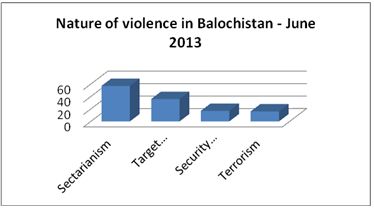 As a result of these sectarian attacks, the following holy places were desecrated in the month of June:
As a result of these sectarian attacks, the following holy places were desecrated in the month of June:
Imambargah in Bilal Colony, Karachi (Casualties: 3 dead, 11 injured)[29]
Mosque in Garngi Payan village, Mathra, Peshawar (1 dead)[30]
Abu Talib imambargah, Hazara Town, Quetta (Casualties: 31 dead, 65 injured)[31]
The suicide attack claimed by the outlawed sectarian organization, Lashkar-e-Jhangvi, resulted in death of 14 students, 4 nurses, and 4 soldiers.
Drone Attacks
On June 7, US drone killed 7 militants in North Waziristan. The missiles hit a compound in Shokhel village, more than 100 kilometeres southwest of Miranshah, the main own of North Waziristan that is known as a stronghold of Taliban and al Qaeda-linked militants[32]. While this drone attack diminished the chances of the well trumpeted efforts of the two leading mainstream political parties for striking a peace deal with the Taliban, it also revealed that the new government was also incapable of stopping these CIA-led attacks.
However, this attack with seven casualties drew more attention of many parliamentarians than the over 600 casualties of target killings, suicide bomings, and sectarianism. In one month only, Taliban, Lashkar-e-Jhangvi, Lashkar-e-Islam, BLA, and Junood Hifsa claimed responsibility for acts of violence that left nearly 100 people dead and over 150 persons wounded.
Maulana Fazlur Rehman of JUI-F was reported to have suggested to the prime minister, Nawaz Sharif, that to look credible in the eyes of Taliban, the government will have to back the protest over drones with the readiness to downgrade its ties with Washington[33].
Tags: Pakistan Conflict, Conflict Tracker, Pakistan-Violence, Karachi, Pakistan-Target Killings, Balcohistan, Baloch-Nationalists, BLA, Junood Hifsa, BRA, JeM, Jaishe Mohammad, Lashkare Taiba, Lashkar-e-Jhangvi, Lashkar-e-Islam, Dera Ismail Khan, Waziristan, Pakistan-Waziristan, Secatrianism, Pakistan- Secatrianism, Abductions for ransom, Taliban, Pakistani Taliban, Nawaz Sharif-Pakistan, Ziarat Residency, Drones, Drone-strikes , Pakistan-Drone Strikes, TTP, PTI, PML-N, Tehreeke Taliban, Punjab, Pakistan-Punjab, suicide attacks, military operations, Pakistan military operations, Maulana Fazlurrehman, JUI-F, Shia-Hazara, Hazara, Quetta- sectarianism,
[1] http://www.dailytimes.com.pk/default.asp?page=2013\06\22\story_22-6-2013_pg7_2
[2] http://images.thenews.com.pk/01-06-2013/ethenews/e-181086.htm
[3] http://www.dailytimes.com.pk/default.asp?page=2013\06\16\story_16-6-2013_pg7_7
[4] http://images.thenews.com.pk/23-06-2013/ethenews/e-185342.htm
[5] http://images.thenews.com.pk/15-06-2013/ethenews/e-183898.htm
[6] http://images.thenews.com.pk/01-06-2013/ethenews/e-181270.htm
[7] http://images.thenews.com.pk/02-06-2013/ethenews/e-181312.htm
[8] http://images.thenews.com.pk/02-06-2013/ethenews/e-181401.htm
[9] http://images.thenews.com.pk/08-06-2013/ethenews/e-182568.htm
[10] http://images.thenews.com.pk/06-06-2013/ethenews/e-182145.htm
[11] http://images.thenews.com.pk/07-06-2013/ethenews/e-182347.htm
[12] http://beta.dawn.com/news/1015134/blasts-kill-one-injure-three-in-bannu
[13] http://images.thenews.com.pk/12-06-2013/ethenews/e-183346.htm
[14] http://images.thenews.com.pk/12-06-2013/ethenews/e-183348.htm
[15] http://tribune.com.pk/story/561796/terrorists-in-police-uniform-try-to-kidnap-shia-doctor-in-peshawar/
[16] http://www.dailytimes.com.pk/default.asp?page=2013\06\14\story_14-6-2013_pg7_6
[17] http://images.thenews.com.pk/17-06-2013/ethenews/t-23555.htm
[18] http://images.thenews.com.pk/20-06-2013/ethenews/e-184799.htm
[19] http://images.thenews.com.pk/20-06-2013/ethenews/e-184801.htm
[20] http://images.thenews.com.pk/29-06-2013/ethenews/t-23799.htm
[21] http://images.thenews.com.pk/19-06-2013/ethenews/t-23600.htm
[22] LeJ claims twin attacks http://www.dailytimes.com.pk/default.asp?page=2013\06\17\story_17-6-2013_pg1_4 “Abubakar Siddiq, a spokesman for LeJ, called newspaper offices in Quetta late Saturday to claim the killings. “The suicide attack on the bus was carried out by one of our sisters. She boarded the student bus and blew herself up,” Siddiq said. “Then we carried out a second suicide attack at the hospital and our fighters killed several people. We did this because security forces killed our fighters and their wives in Kharotabad.” Pakistani security forces on June 6 killed at least three militants and two women during a raid at a house in the Kharotabad neighbourhood of Quetta. Officials said they belonged to Tehreek-e-Taliban Pakistan, with whom LeJ has links.”
[23] http://images.thenews.com.pk/07-06-2013/ethenews/t-23334.htm
[24] http://www.thenews.com.pk/article-105633-Achakzai-for-inclusion-of-US-in-Taliban-peace-talks
[25] http://images.thenews.com.pk/19-06-2013/ethenews/t-23597.htm
[26] http://tribune.com.pk/story/566616/not-doomsday-mardan-residents-burn-shaukat-yousafzais-effigy/
[27] LeJ claims twin attacks http://www.dailytimes.com.pk/default.asp?page=2013\06\17\story_17-6-2013_pg1_4
[28] http://tribune.com.pk/story/570514/2-killed-in-quetta-explosion/
[29] http://images.thenews.com.pk/22-06-2013/ethenews/t-23651.htm
[30] http://tribune.com.pk/story/567784/in-cold-blood-dsp-traffic-guard-killed-in-saeedabad/
[31] http://tribune.com.pk/story/570514/2-killed-in-quetta-explosion/
[32] http://www.dailytimes.com.pk/default.asp?page=2013\06\08\story_8-6-2013_pg7_1
[33] http://beta.dawn.com/news/1017274/taliban-wants-govt-to-distance-itself-from-drone-attacks